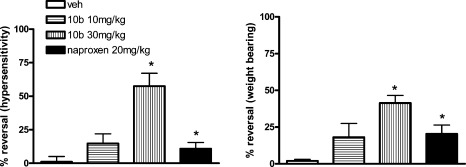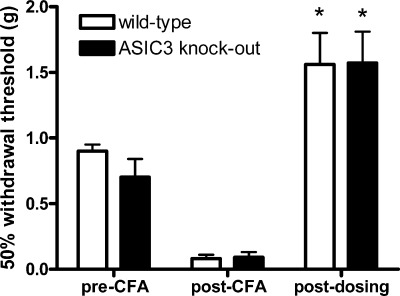This product is for research use only, not for human use. We do not sell to patients.

| Size | Price |
|---|---|
| 250mg | Get quote |
| 500mg | Get quote |
| 1g | Get quote |
Cat #: V3091 CAS #: 371217-32-2 Purity ≥ 98%
Description: A-317567 (A317567) is a novel non-amiloride inhibitor of the acid-sensing ion channel (ASIC) (IC50 = 1.025 μM) with antidepressant and antinociception effects. It acts on three distinct types of native ASIC currents evoked in acutely dissociated adult rat dorsal root ganglion (DRG) neurons. A-317567 produced concentration-dependent inhibition of all pH 4.5-evoked ASIC currents with an IC50 ranging between 2 and 30muM, depending upon the type of ASIC current activated. Unlike amiloride, A-317567 equipotently blocked the sustained phase of ASIC3-like current, a biphasic current akin to cloned ASIC3, which is predominant in DRG. When evaluated in the rat Complete Freud's Adjuvant (CFA)-induced inflammatory thermal hyperalgesia model, A-317567 was fully efficacious at a dose 10-fold lower than amiloride.
Publications Citing InvivoChem Products
Product Promise

- Physicochemical and Storage Information
- Protocol
- Related Biological Data
- Stock Solution Preparation
- Quality Control Documentation
| Molecular Weight (MW) | C27H31N3 |
|---|---|
| Molecular Formula | 397.57 |
| CAS No. | 371217-32-2 |
| Storage | -20℃ for 3 years in powder form |
| -80℃ for 2 years in solvent | |
| Solubility In Vitro | DMSO: 10 mM |
| Water: N/A | |
| Ethanol: N/A | |
| Synonyms | A317567; A 317567; A-317567 |
| Protocol | In Vitro | The effects of A-317567 (A317567) on three distinct types of native ASIC currents evoked in acutely dissociated adult rat dorsal root ganglion (DRG) neurons are studied. A-317567 produces concentration-dependent inhibition of all pH 4.5-evoked ASIC currents with an IC50 ranging between 2 and 30 μM, depending upon the type of ASIC current activated. A-317567 equipotently blocks the sustained phase of ASIC3-like current, a biphasic current akin to cloned ASIC3, which is predominant in DRG[2]. |
|---|---|---|
| In Vivo | A-317567 (A317567) is fully analgesic effects in the CFA model (ED50 of 17 μmol/kg, i.p., adult male Sprague-Dawley rats). There is no significant effect of A-317567 on the withdrawal latency of the contralateral paw under these conditions[2]. |
This equation is commonly abbreviated as: C1 V1 = C2 V2
- (1) Please be sure that the solution is clear before the addition of next solvent. Dissolution methods like vortex, ultrasound or warming and heat may be used to aid dissolving.
- (2) Be sure to add the solvent(s) in order.







































